|
|
||||||
The joint
MBL-CENA group has identified several key changes
in terrestrial ecosystems that are associated with
the conversion of forest to pasture. Pasture soils
have higher pH levels because of the ash deposited
after forest vegetation is burned. They also have a
higher availability of phosphorus, lower
availability of inorganic nitrogen and lower
production of nitrate than forest soils. With these
results in mind, we developed a hypothesis about
the ways in which changes in soil nitrogen and
phosphorus dynamics are linked to stream chemistry
and productivity (Figure 1). Because
phosphates associated with iron and aluminum, which
dominate those of tropical soils, are more soluble
at high pH levels, we suspect that the higher pH of
pasture soils leads to greater availability of
soluble phosphorus. Along with potentially greater
erosion of particulate phosphorus from pastures,
this availability increases the amount of
phosphorus reaching streams. We hypothesized that
this alteration in the relative availability of
nitrogen and phosphorus would lower ratios of
nitrogen to phosphorus in stream water and lead to
nitrogen limitation of algal production in pasture
streams. Ratios
greater than 16:1 indicate phosphorus limitation of
algal growth, whereas ratios less than 16:1
indicate nitrogen limitation. Therefore phosphorus
should limit algal production in forest streams if
the light limitation is removed, and nitrogen
should limit algal growth in pasture streams. The
higher nitrate concentrations in streams draining
forested areas compared with those found in pasture
streams differ from the pattern found in temperate
zone ecosystems, where nitrate losses are generally
higher from disturbed or altered sites. While
concepts gained from temperate North American
streams can guide research on tropical ecosystems,
there is no substitute for field studies. The
chemistry of old, highly-weathered tropical soils
and the intricate biological relationships in
places like the Amazon are likely to yield
surprises. We plan to expand our studies by
examining rates of in-stream nutrient processing to
determine how long the influences of forest or
pasture environments are maintained downstream.
This is important in a region where streams pass
through a mosaic of forest and pasture. Will a
stream segment of several kilometers through forest
eliminate the effects of upstream pasture land use?
These kinds of questions will be important for
predicting how the cumulative changes in small
watersheds will influence larger tributaries and
ultimately the Amazon River itself. The fate of
algae produced in streams that now run through an
increasingly deforested landscape will also be the
subject of future studies. A diverse assemblage of
aquatic animals, particularly freshwater fishes,
uses the river networks of the Amazon Basin. Most
have life histories and seasonal migration patterns
that are closely tied to annual flooding and the
location of areas with high algal production. We
currently know very little about these complex
relationships or how they will be affected by the
changes brought by deforestation. But there is much
knowledge about tropical aquatic ecosystems to be
gained by focusing on small watersheds, where the
ecological functioning of streams is tightly
coupled with activities on the land.
![]()
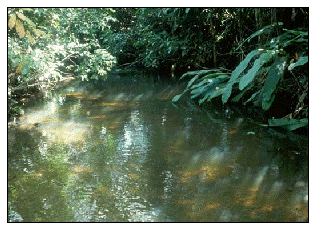 Although
most of our knowledge about the effects of human
activity on both terrestrial and aquatic ecosystems
comes from studies in the temperate regions of
North America, the most extensive and rapid
conversion of natural ecosystems into crop and
pastureland today is taking place in the tropics.
Clearing of rain forest for cattle pasture is
currently the most common form of land-use change
on earth. This state of affairs is particularly
true in the Amazon Basin, home to the world's
largest remaining tropical forest ecosystem, where
about 70% of the cleared land is used for cattle
grazing.Recently we have focused on how the
clearing of forest for pasture changes the
chemistry and ecology of small streams in the
Brazilian Amazon. Small streams are of interest
because they are the corridors that connect
terrestrial ecosystems with larger
rivers.
Although
most of our knowledge about the effects of human
activity on both terrestrial and aquatic ecosystems
comes from studies in the temperate regions of
North America, the most extensive and rapid
conversion of natural ecosystems into crop and
pastureland today is taking place in the tropics.
Clearing of rain forest for cattle pasture is
currently the most common form of land-use change
on earth. This state of affairs is particularly
true in the Amazon Basin, home to the world's
largest remaining tropical forest ecosystem, where
about 70% of the cleared land is used for cattle
grazing.Recently we have focused on how the
clearing of forest for pasture changes the
chemistry and ecology of small streams in the
Brazilian Amazon. Small streams are of interest
because they are the corridors that connect
terrestrial ecosystems with larger
rivers. 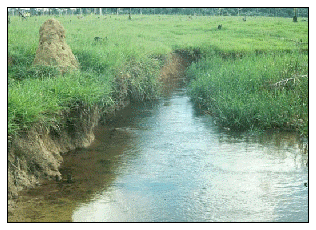 As
the accompanying photographs show, some of the
effects of forest clearing are direct and obvious.
Elimination of the forest canopy increases light
reaching the stream surface. Surface water runoff
increases because rainfall interception and
transpiration by trees are reduced, and the
potential for increased sedimentation becomes
greater. Cattle trample the banks of streams. Other
consequences of forest clearing are more subtle.
Clearing alters the availability and proportion of
nutrients in formerly forested soils and thus the
likelihood that these nutrients will make their way
into streams.We are conducting our study in
Rondônia, a state in the southwestern part of
the Amazon Basin, which has experienced an
explosive growth in the conversion of forested land
into cattle pasture since the early 1980s. We are
working at Fazenda Nova Vida, which has been the
location of other studies of the effects of forest
clearing for pasture on soil organic matter,
nitrogen cycling and exchanges of trace gases with
the atmosphere.
As
the accompanying photographs show, some of the
effects of forest clearing are direct and obvious.
Elimination of the forest canopy increases light
reaching the stream surface. Surface water runoff
increases because rainfall interception and
transpiration by trees are reduced, and the
potential for increased sedimentation becomes
greater. Cattle trample the banks of streams. Other
consequences of forest clearing are more subtle.
Clearing alters the availability and proportion of
nutrients in formerly forested soils and thus the
likelihood that these nutrients will make their way
into streams.We are conducting our study in
Rondônia, a state in the southwestern part of
the Amazon Basin, which has experienced an
explosive growth in the conversion of forested land
into cattle pasture since the early 1980s. We are
working at Fazenda Nova Vida, which has been the
location of other studies of the effects of forest
clearing for pasture on soil organic matter,
nitrogen cycling and exchanges of trace gases with
the atmosphere.
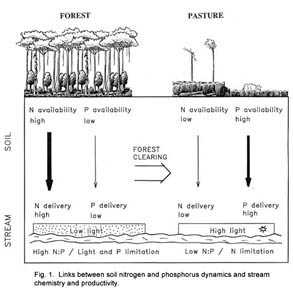 According
to our hypotheses, the relatively high availability
of nitrogen and low availability of phosphorus in
forest soils results in a high movement of nitrogen
and low movement of phosphorus into streams.
Because forest streams have high ratios of nitrogen
to phosphorus, algal growth is limited by
phosphorus where it is not already limited by low
light levels in the shade of trees. After pastures
are established, both soil nitrogen availability
and the flow of nitrogen into streams
decline.
According
to our hypotheses, the relatively high availability
of nitrogen and low availability of phosphorus in
forest soils results in a high movement of nitrogen
and low movement of phosphorus into streams.
Because forest streams have high ratios of nitrogen
to phosphorus, algal growth is limited by
phosphorus where it is not already limited by low
light levels in the shade of trees. After pastures
are established, both soil nitrogen availability
and the flow of nitrogen into streams
decline.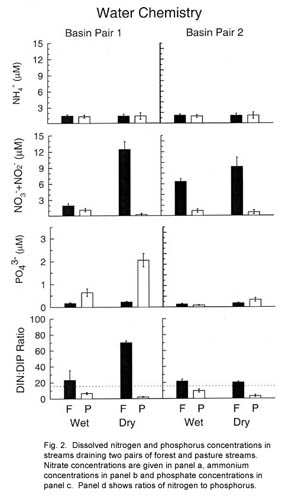 We
tested these ideas by examining the chemistry of
streams draining small watersheds that were either
entirely forested or were entirely covered by
pastures that had been established five years
before. We found that streams draining pasturelands
had lower concentrations of inorganic nitrogen
(nitrate and ammonium) but higher concentrations of
phosphate than the streams draining the native
forest (Figure 2 a-c). Ratios of nitrogen to
phosphorus were 32:1 to 238:1 in the forest streams
but 3:1 to 4:1 in the pasture streams (Figure
2d).
We
tested these ideas by examining the chemistry of
streams draining small watersheds that were either
entirely forested or were entirely covered by
pastures that had been established five years
before. We found that streams draining pasturelands
had lower concentrations of inorganic nitrogen
(nitrate and ammonium) but higher concentrations of
phosphate than the streams draining the native
forest (Figure 2 a-c). Ratios of nitrogen to
phosphorus were 32:1 to 238:1 in the forest streams
but 3:1 to 4:1 in the pasture streams (Figure
2d). 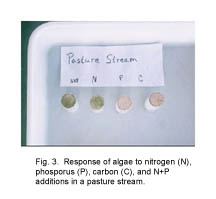 In
order to see how changes in nutrient inputs caused
by pasture creation would affect the base of the
stream food web, we also performed bioassays to
determine the response of the algae to added
nitrogen or phosphorus (Figure 3). In these assays,
nitrogen or phosphorus was added to agar contained
in small bottles topped with porous ceramic disks.
Algae grow on the disks and utilize the nutrients
as they gradually diffuse out of the agar. One
assay was located in a forest steam, the other in a
pasture stream. In the forest stream assay, neither
nitrogen nor phosphorus increased algal production,
indicating that light rather than nutrients limited
algal growth. In the pasture stream assay, algae,
responded to both nitrogen and nitrogen plus
phosphorus. These results supported the original
hypothesis and demonstrated clearly how changes in
soils of the upland, or terra firme, forests
are linked to stream productivity. They also showed
that watershed clearing caused a switch from one
limiting nutrient to another.
In
order to see how changes in nutrient inputs caused
by pasture creation would affect the base of the
stream food web, we also performed bioassays to
determine the response of the algae to added
nitrogen or phosphorus (Figure 3). In these assays,
nitrogen or phosphorus was added to agar contained
in small bottles topped with porous ceramic disks.
Algae grow on the disks and utilize the nutrients
as they gradually diffuse out of the agar. One
assay was located in a forest steam, the other in a
pasture stream. In the forest stream assay, neither
nitrogen nor phosphorus increased algal production,
indicating that light rather than nutrients limited
algal growth. In the pasture stream assay, algae,
responded to both nitrogen and nitrogen plus
phosphorus. These results supported the original
hypothesis and demonstrated clearly how changes in
soils of the upland, or terra firme, forests
are linked to stream productivity. They also showed
that watershed clearing caused a switch from one
limiting nutrient to another.